

| Photo | Name | Constructed / Dedicated | Purpose |
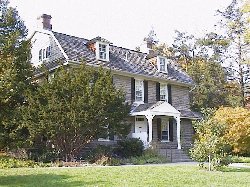 |
Benjamin West House | 1724 |
Ben West houses the headquarters of Public Safety at Swarthmore and also serves
as the visitor information center. The building is named after the famous American
painter Benjamin West, who was born in the house in 1738. The house was acquired by
Swarthmore College in 1874 when it purchased the farm the house was built upon.1
|
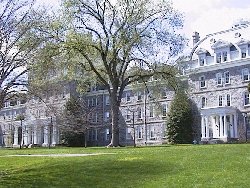 |
Parrish Hall | 1868 |
Parrish is the central building of Swarthmore College. It was the first building
constructed by the college and originally served not only as a residence hall, but
also as an academic building, administrative center, dining hall - in essence, the
entire college.2 Today the entire first floor and half of the second floor
houses administrative offices; the other half of the second floor and all of the third
and fourth floors serve as dorm space for students. The post office, student activity
boards, and two large meeting rooms (Parrish Parlours) are located on the first floor.
Student organizations, including WSRN 91.5 FM, The Phoenix, and SCCS, have offices on
the fifth floor of Parrish. A major renovation of the building is scheduled from
January 2007 to September 2009. As a dorm, Parrish is one of the more difficult places for students to choose into during the housing lottery. The student population is comprised mainly of seniors and juniors in singles, with very few sophomores and a reasonable number of first-years. First-year students are typically housed in doubles, though there are several triples on each floor. All rooms have hardwood floors and most have very spacious ceilings - some rooms are taller than they are wide. Parrish is the one dorm that is not entirely co-ed: the east side of the building houses females, and the west side houses males. Though it's the third-largest dorm and enjoys a perfect location in the center of campus, Parrish does not have much hall life, allowing students to study in their rooms without the distractions found in some of the rowdier dorms. No smoking is allowed anywere in Parrish. Population: 159 students
First-Year Students: 37
|
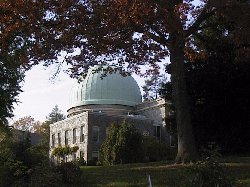 |
Sproul Observatory | 1878 |
Sproul Observatory was originally constructed as the President's House in 1878, making
it the second building constructed by Swarthmore College. In 1911, William Cameron
Sproul '91 donated funds to the College to renovate the building into an observatory.
The observatory's telescope spans nearly the entire diameter of the dome, and is still
in use today. Sproul now holds the offices of Astronomy and Computer Science; the
CS Sun Lab on the second floor was completely renovated in the summer of 1998.
|
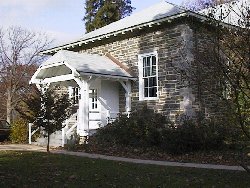 |
Friends Meeting House | 1880 |
Swarthmore was originally founded as a Quaker institution, and remained affiliated to
the Religious Society of Friends until the early 1900's. Funds for the meeting house
were given by Joseph Wharton, who served as the President of the Board of Managers
from 1883-1907.
|
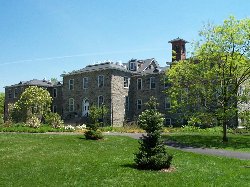 |
Trotter Hall | 1881 |
Trotter Hall was the first academic building built after Parrish Hall. Originally
named Science Hall, it was constructed for the study of the natural sciences - on
the south face of the building are inscribed the words, "Engineering, Physics, Chemistry".
The east wing of the building was added in 1920 and dedicated as the "Trotter Laboratory
of Biology," named after a popular professor, Spencer Trotter. In 1937, the entire building
was renamed to Trotter Hall in his memory. In 1959 the last physics class was taught in
the building - since then, no natural sciences have been taught in Trotter. After the
completion of Kohlberg in 1996, the interior of the building was completely gutted and
reconstructed; work was completed in late 1997.3 Trotter is currently home to the
departments of Political Science and History.
|
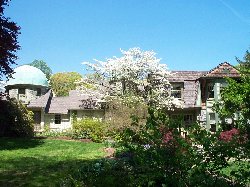 |
Cunningham House | 1888 | The Cunningham House was built for Susan J. Cunningham, a professor of astronomy in Swarthmore's early years. The house was built both as a residence for her and also as an observatory; the domes where the telescopes were housed are still in existence today. The house was acquired by the College upon Cunningham's death in 1921.4 It is currently used as the headquarters of the Scott Arboretum. |
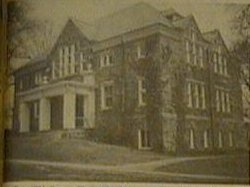 |
Sommerville Hall | 1894 |
Sommerville was originally constructed as a women's gym in the same place that
McCabe Library now stands. It was used as a gymnasium until 1956, when it was
converted to a student union building, somewhat akin to today's Tarble Social Center.
Phoenix articles from the era suggest that the student body very nearly panicked when
the decision was made to raze the building to make room for the new library. Suggestions
for locations for an "Interim Soms" ranged from Parrish basement to the lower level
of Willets. Eventually a new student union, the Tarble Social Center, was built in the
Clement Biddle Memorial Library wing of Carnegie Library - better known to current
students as Old Tarble. Sommerville was demolished soon after May 6, 1966.
|
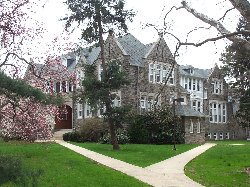 |
Roberts Hall | 1898 |
Roberts Hall was originally one of three buildings in the Swarthmore Preparatory
School, a boarding school for boys which closed in 1933.1 Swarthmore
acquired the three buildings in 1935. Roberts, along with Pittenger and Palmer, is
located on the far side of the athletic fields from the main campus. There are a
variety of room options available, with everything from singles to quints - and most
rooms even have their own bathrooms. This dorm is fairly easy for sophomores to
choose into, though juniors and seniors are present, as well. No first-year students
are assigned to Roberts. Population: 43 students
|
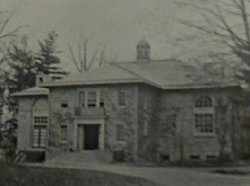 |
Hall Gymnasium | 1898 |
Hall Gymnasium was built as the male counterpart to the women's Sommerville Gym. It
apparently had a relatively uneventful history, except that it was once used as a dorm
for overflow housing after soldiers returned from World War II. Hall Gymnasium was
demolished in 1989 to make room for the Lang Performing Arts Center.
|
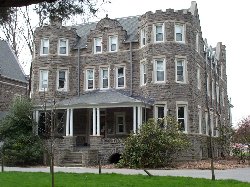 |
Palmer Hall | 1901 |
Palmer, another third of PPR (Palmer, Pittenger, and Roberts), is a popular dorm with
upperclassmen who wish to live off campus. Because of its relatively small size and
isolation, Palmer (and Pittenger and Roberts, for that matter) doesn't have much in
the way of hall life. On the first floor of Palmer there is a large lounge, which it
shares with residents of Pittenger. Palmer and Pitt are connected both via an unheated
first-floor walkway and a shared labyrinth-like basement. No first-year students
are assigned to Palmer. Population: 30 students
|
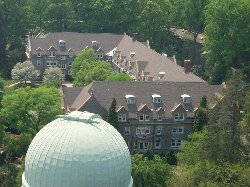 |
Wharton Hall | 1903 |
Wharton Hall was the first residence hall constructed by Swarthmore College. Originally
designed as a men's dorm, it was built in three sections over the course of 14
years. Construction on A/B (west) lasted from 1903 to 1904, E/F (east) from 1909 to 1910,
and C/D (central) from 1916 to 1917. Each section was built to be completely autonomous
from the others; students must exit the dorm to go from one section to another. Wharton is one of the most popular dorms on campus, and with very good reason. All Wharton rooms are of comparable size to the nicer rooms in other Swarthmore dorms, but some are huge by comparison. For example, one particular freshman double on A/B 3rd is almost two times the size of a freshman double in Willets. Wharton has a variety of room choices, including singles, one- and two-room doubles, two-room triples, and two- and three- room quads. Every floor of each section has two small lounge areas, though the building lacks a large commons area found in many dorms. The division of the building into three distinct units allows it to support a population as large as Willets' without all the noise associated with it. Nonetheless, Wharton is still a very social dorm, especially A/B and E/F, which house all of the dorm's first-year students. Wharton enjoys a location near the very center of campus - the only closer dorm is Parrish itself. Population: 216 students
First-Year Students: 68
|
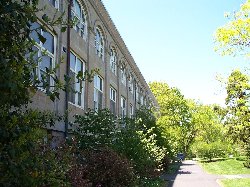 |
Beardsley Hall | 1904 |
Beardsley Hall is named after Swarthmore's first professor of Engineering. Sometime
after its construction, the building's size was expanded by about one third -
on the side near Dupont, there is a noticible difference in the coloring of the brick,
and also a smaller window on the third floor to indicate where the end of the building
once was. The inside of Beardsley is relatively old and utilitarian compared to most
other academic buildings on Swarthmore's campus. The first floor and part of the second
house the computing center; there is a large and newly renovated (Summer '99) public
computing lab on the first floor. The rest of the building is used for studio art and
art history. Student works can be found hanging on the corridors of the third floor.
|
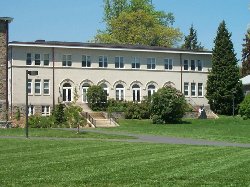 |
Pearson Hall | 1904 | Pearson is home to the departments of education, linguistics, and religion, as well as the Office of Foreign Study. Though it is clearly an old building, the interior has been recently renovated and is in extremely good shape. |
 |
Temple of the Book & Key | 1906 |
The Temple of the Book & Key was the home to Swarthmore's only secret society.
It was originally organized by alumni in the early 1900's who felt that Swarthmore,
like other prestigious colleges, needed its own secret society. Only seven senior
men were active members of the society at any given time; the induction of new members
took place in May of a student's junior year. Over time the secrecy of the organization
vanished, and the college community grew tired of the notion of a 'secret society'. Book
& Key remained in existence until 1957, when its members decided not to induct any new
members for that year. The temple itself was demolished in 1967.4 Articles on Book & Key can be found on Elizabeth Weber's Swarthmore history page and in the December 1999 Alumni Bulletin.
|
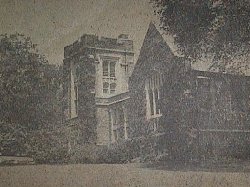 |
Carnegie Library | 1907 | Carnegie Library was the first building constructed for the sole purpose of being a library. Until Carnegie was built, the main library had been located in Parrish. Other buildings had libraries specifically suited to the building's purpose - Science Hall, for example, contained the college's science library. The Libe, as Carnegie was commonly known, was built between the present-day locations of McCabe and Old Tarble. In fact, Old Tarble was constructed 21 years later as an additional wing to the library. Carnegie served as the college's library until 1967, when the construction of McCabe Library was completed. Sommerville Hall, which housed the student social center, was demolished to make room for McCabe, so the college decided to convert Carnegie into the new student union building - Tarble Social Center. It served in that capacity until September 16, 1983, when an arsonist set fire to the building and almost completely destroyed it. The lone wing that remains today is Old Tarble. |
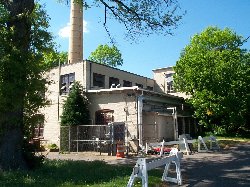 |
Heating Plant | 1911 |
The Heating Plant, located near the athletic facilities and next to the SEPTA rail,
serves as a facilities plant for the college. It also has an entrance to the steam
tunnels that run under the campus to the west wing of Parrish.
|
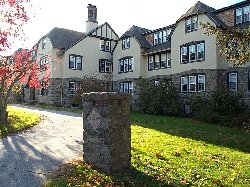 |
Mary Lyon Building 4 | 1917 |
Mary Lyons is a 8-minute walk from the edge of campus and a 12-minute walk from Parrish,
making it Swarthmore's farthest off-campus dorm. While the distance and isolation from
campus isn't for everyone, most ML residents enjoy it and wouldn't trade their dorm
for any on-campus residence. Students who find themselves at the bottom of the housing
lottery can usually expect a room in the ML basement. Mary Lyons is composed mainly of doubles and singles, with only one triple on the first floor. Most rooms are slightly larger than their on-campus equivalents, though several of the sophomore doubles are easily twice the size of the average double. Rooms on the first, second, and part of the third floor have private or semi-private bathrooms. The remaining bathrooms on the third floor and all of bathrooms in the basement are co-ed. ML has a huge lounge which covers about a third of the first floor and a smaller lounge on the second floor of the building. The most unique feature of Mary Lyons is the breakfast room - because of the distance from campus, students can opt to eat breakfast in their own dorm. The social life in Mary Lyons is fairly dead during the day when most students are away at campus, but usually becomes quite active at night once students return. ML probably has the best sense of community among any of the dorms at Swat. The science fiction / fantasy club, SWIL, has a strong presence in the dorm. More on the history of the Mary Lyon buildings. Population: 102 students
First-Year Students: 30
|
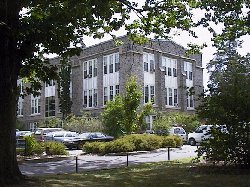 |
Hicks Hall | 1919 |
Hicks Hall is the home of Swarthmore's renowned Engineering Department. In
addition to classrooms and offices, there are many laboratories scattered
throughout (and on top of) the building. On the third floor of Hicks, there
is a room whose walls are covered with a 1930's mural depicting War, Peace,
Science, and Poverty. For more information, see an article from the December
3, 1999 Phoenix.
|
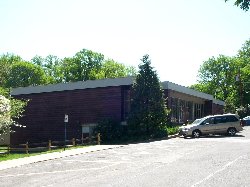 |
Squash Court Building | 1920 |
The Squash Court Building, located by the Field House and Ware Pool,
holds playing courts for the game of squash.
|
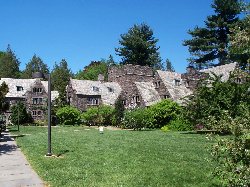 |
Worth Hall | 1924 |
Worth Hall was originally constructed as Swarthmore's first women's dorm. Somewhat like
Wharton, the building is divided up into six sections (I - N), though each pair of sections
is connected (I-J, K-L, M-N) with passageways on the second floor. Each floor in a unit
is composed of several rooms opening onto a small common space and stairway - instead of
the traditional horizontal hall, the halls in Worth are vertical. This arrangement
effectively prevents the dorm from being a very social place, unless a group of friends
choose to block together in a particular section. Most rooms are singles or two-room
doubles, though there are several two- and three-room triples, as well. All of the
sections are three stories tall, with the exception of K, which is four stories. The
quiet atmosphere and great rooms make Worth the first dorm to be filled up in the
housing lottery - for the '98-'99 school year, only two sophomores were able to choose
into the dorm; the rest were juniors and seniors. No first-year students are assigned
to Worth. Population: 74 students
|
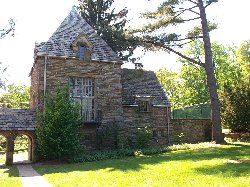 |
Women's Resource Center | 1925 |
The WRC was originally constructed as the Kappa Sigma Pi fraternity lodge. In the
1920's and 1930's, the vast majority of Swarthmore students were members of a fraternity
or sorority. In 1932, all of the sororities decided to stop accepting new pledges
and voluntarily disbanded to avoid excluding the small minority who were not members.
Most of the men's fraternities, except for Delta Upsilon and Phi Kappa Psi, eventually
followed suit - but not for many more years. Today, the Women's Resource Center is
used as the headquarters of various student groups and also serves as a common space
for meetings.
|
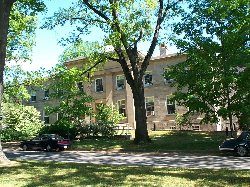 |
Papazian Hall | 1926 |
Papazian is Swarthmore's only academic building that was not built by the
College. The Bartol Foundation, a research arm of the Franklin Institute,
originally established a lab in the borough of Swarthmore in 1924. Only days
after the atomic bombs were dropped on Japan, it was revealed that the Bartol
Foundation had been involved in atomic research for all of the 21 years that
it had been at Swarthmore.5 The building now known as Papazian was
built several years later, in 1948, as an additional research laboratory for the
Foundation. Students and professors alike were employed there doing research
until 1978, when the College purchased the building and restored it.3
Today, Papazian is home to philosophy, psychology, and an engineering laboratory.
Some students say that the building is a psychological experiment in and of
itself - its Escheresque architecture and bizarre interior design leave many
wondering if they are not simply rats running around in a maze.
|
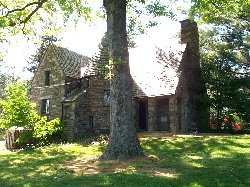 |
Olde Club | 1926 |
Olde Club was originally the home of the Tau Alpha Omicron fraternity. Nowadays it
is frequently the location of parties on Friday and Saturday nights, though it is
occasionally used for other purposes, such as plays and other drama productions.
|
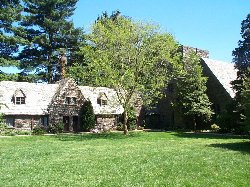 |
Bond Hall & The Lodges | 1927 |
Bond Hall and the Lodges were the first buildings constructed solely for the social
use of Swarthmore women. On October 1, 1925, an alumnae fund drive was undertaken to
build lodges for the six sororities and a common meeting space for all women - Bond
Hall. Each sorority pledged $10,000 for the construction of their lodge for a total of
$60,000, and Bond itself cost another $60,000. After construction was completed, five
students lived in each lodge for the year, and presumably continued to do so even
after the sororities disbanded. Currently Lodges 1-4 and 6 house a block of five
sophomores each year; Lodge 5 is now used for storage space. Each lodge has a triple
on the first floor and a double on the second floor; in addition, there is a bathroom
and storage space in the basement. Bond Hall is used as a general student meeting
space. No first-year students are assigned to the Lodges. Population: 25 students
|
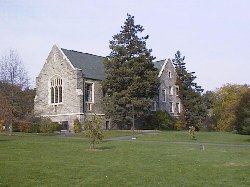 |
Old Tarble | 1928 |
The building known today as Old Tarble was constructed as a wing to Swarthmore's
original library, Carnegie. It was first known as the Clement Biddle Memorial
Library Wing and housed the Friends Historical Library. It was used in this
capacity until sometime shortly after 1967, when McCabe was completed. Since
the student union building, Sommerville, was demolished to make room for McCabe,
Swarthmore decided to convert the old library into the new student union building,
Tarble. Early on the morning of September 16, 1983, an arsonist set fire to
the building and almost completely destroyed it. The Tarble Social Center was
rebuilt in its present location in Clothier Memorial Hall, and so the remains
of the former student union are called "Old" Tarble. The ground floor is
currently used by art students, and the basement is college storage space.
|
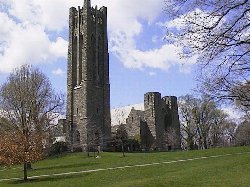 |
Clothier Memorial Hall | 1929 |
A popular rumor that tourguides tell prospective students on campus tours is
that Clothier Hall was originally designed for Princeton University, but because
Princeton procrastinated too long in deciding whether or not to utilitize the
design, the frustrated architect sold his plans to Swarthmore. Whether there
is any truth to this tale is something that has yet to be determined. The large cathedral-like section of the hall once served as an auditorium and congregation point for the college community. After several decades Clothier Hall was no longer able to hold the growing number of students and faculty all at the same time, and the building fell into disuse. The Tarble Social Center was reopened in Clothier in the spring of 1986, but even as late as 1994, not all of the space available to the college was being utilized. The first floor of the building contains the Intercultural Center, a student lounge and snack bar, and Paces, a student-run cafe and common location for parties. Almost the entire second floor is taken up by Tarble All Campus Space, a large two-story open space used for dances, banquets, meetings, and student activities. The offices of some student organizations can be found on the second and third floors. A rarely-used game room and the College Bookstore are in the basement. Recently there has been a push by students to renovate the building into more of a student lounge space.
|
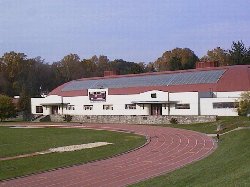 |
Lamb-Miller Field House | 1935 |
The Field House is Swarthmore's main athletic facility. Inside the dome there
is a large two-story open area with a track, basketball courts, tennis courts,
and several weight rooms. The offices of the team coaches are also located in
the Field House. Like the rest of Swarthmore's current athletic buildings, the
building is located on the other side of the SEPTA rail, a short walk from the
center of campus.
|
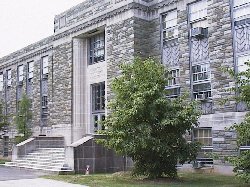 |
Martin Hall | 1937 |
Martin was originally built as the home of the Biology department, and retains
that function to this day. It is one of only two buildings on Swarthmore's campus
which are home to only one department. Though the building is old, it is still in
remarkably good condition; the labs were completely renovated only a few years
ago, as well. Just inside the main entrace to Martin is Kirby Lecture Hall, one
of Swarthmore's two lecture halls, where students sometimes show movies or
hold meetings. In the upcoming renovation of Dupont Science Hall, scheduled from
June 2001 to June 2004, Martin will be joined with Cornell Science & Engineering
Library and Dupont to form a new, unified science complex.
|
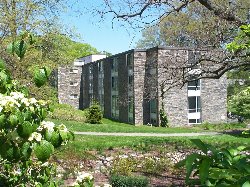 |
Willets Hall | 1958 |
Willets is commonly regarded as the loudest, rowdiest, and most social
dorm on campus, due in no small part to the large number of freshmen assigned
to live there each year. Its reputation for bad smells and drunk inhabitants
(which is only partially deserved) makes Willets one of the last dorms to
be picked in the housing lottery - sometimes it even rivals ML for the honor
of the being last dorm picked. Despite its bad reputation, it is basically
the equivalent of standard institutional housing at most colleges. Each
floor is divided into two halls consisting mainly of doubles and the occasional
single or triple. Each double is 204 square feet, slightly smaller than a
Danawell double, which is 216 sqare feet. The halls share bathrooms and a
large common lounge space on each floor. In addition, Mephisto's Lounge on the
ground floor provides plenty of space for large student gatherings, such as
parties, drama or comedy productions, or movies. Willets was the first major construction project that Swarthmore engaged in after World War II; it was originally designed as a women's dorm to complete the Worth - Bond/Lodges quad. As early as 1946, the College was planning on building a new dorm (Willets), physics & chemistry building (Dupont), and library (McCabe). A sketch of the proposed dorm in 1946 depicts a large, blocky, castle-like building similar in design to Worth, but with an exterior more like Wharton. By October 1957, though, the Board of Managers had decided that duplicating Worth's architecture would be cost-prohibitive, and in December 1957 settled on the utilitarian design that we know today. Willets cost in the range of $810,000 - $900,000 and was originally intended to house approximately 180 students (rather than the 210+ it now houses). Construction began on April 1, 1958 and lasted 12 months; it was first occupied in Fall 1959. Population: 209 students
First-Year Students: 95
|
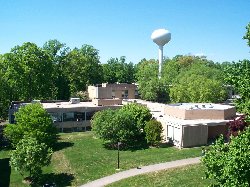 |
DuPont Science Hall | 1960 |
Dupont is the home to chemistry, math, physics, and astronomy at Swarthmore.
The building is composed of four wings around a central courtyard; its height
varies from one to three stories (counting the basement). Dupont has classrooms,
lab space, several public computer labs, a lecture hall, and offices. It is
scheduled for a major renovation from June 2001 - June 2004; whatever parts of
the building are not demolished will be completely reconstructed, and the building
will be linked with Cornell and Martin. The College plans to make better use of the
space Dupont takes up and also make it more aesthetically pleasing (right now Dupont
is considered by many to be the ugliest building on campus). Swarthmore is also
planning to add a "Science Commons" area to Dupont, much like the Coffee Bar that
exists in Kohlberg right now. Progress on the renovation can be found at
http://www.swarthmore.edu/NatSci/sciproject/.1 Swarthmore College planned on building Dupont almost 14 years before construction actually began on the building. One of the earliest sketches of the proposed science hall envisions a simple two-story building in the same basic shape as Wharton with a small belltower in the middle. Of course, this idea never made it past the planning stages, and the result was a building that made no attempt to fit in with Swarthmore's architectural scheme. Even immediately after its completion, the Phoenix labeled it as only being "purely functional."
|
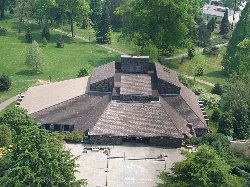 |
Sharples Dining Hall | 1964 |
Sharples is Swarthmore's only dining hall, in accordance with the Quaker tradition
that everyone should eat under the same roof. The central serving area has different
sections for grill, deli, vegetarian (etc.) meals, along with a salad bar. The
central section of the building opens out onto three dining halls of varying sizes,
along with three smaller rooms for meetings and language tables. Before Sharples
was built, the large central room on the first floor of Parrish (now the Office
of Admissions) served as the college's dining hall.
|
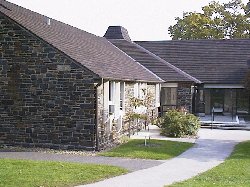 |
Worth Health Center | 1965 |
Worth Health Center is Swarthmore's only medical facility. It is equipped with
basic medical supplies and has several rooms where ill students can spend the
night. Serious injuries must be dealt with at an off-campus hospital.
|
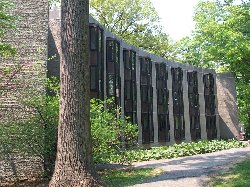
|
Dana Hall & Hallowell Hall | 1967 |
Dana and Hallowell are identical dorms situated on the edge of campus by the
Crum Woods. The first, second, and third floors of both buildings were
designed to have eight singles, eight doubles, and two lounges, but a housing
crunch necessitated the conversion of one of the lounges on each floor into
a double. In addition, the basement level of each dorm was intended to hold
a lounge, kitchen, and several study rooms; both basements were renovated in
the mid-90's so that they could be used as additional dorm space. The interior
hallways of Danawell are short and have many corners - in fact, no section of
the hallway is longer than 12 feet. They were the last men's dorms constructed
before the college switched to co-ed housing. Another popular myth that tourguides tell prospective students is that Dana and Hallowell are riot-proof; the segmented corridors were designed to prevent students from gathering to stage an insurrection (after all, the dorms were built in the late 60's). While there is no truth to this claim, the corridors do ensure that the dorms are less social than Willets or Wharton, though they are by no means quiet or antisocial. The great view, bay windows, and decent location close Dana and Hallowell out towards the middle of the housing lottery - they aren't wildly popular like Wharton and Worth, but they're still great places to live and easily beat Willets or ML. Like Parrish and Woolman, Dana is an entirely non-smoking dorm. Dana Population: 96 students
First-Year Students: 40 Hallowell Population: 93 students
First-Year Students: 36 More on the history of Dana and Hallowell.
|
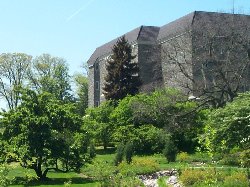 |
McCabe Library | 1967 |
McCabe Library is Swarthmore's main library and home to more than 880,000
volumes as of 1997. The four-story monolith also contains the Friends
Historical Library, the Peace Collection, and various periodicals, newspapers,
and videos. McCabe can seat approximately 600 students in study carols,
lounge areas, and honors study rooms. Despite its vast resources, many
students dislike McCabe because of its dull red carpet, uncomfortable
seating, and lack of natural lighting. Indeed, when McCabe first opened
in 1967, the first concern expressed by the Phoenix was the lack of window
space in the building. A major renovation of McCabe is scheduled from
September 2010 to June 2011. Plans for a new library first manifested themselves after the end of World War II, in November 1946. The first sketch that appeared of the proposed library depicted a large, blocky, three-story building with many large windows. Like the original proposals for Dupont and Willets, though, the proposed architecture would change considerably before the building was constructed. By October 1965, plans for McCabe had been finalized and were estimated at $3 million. The Sommerville student union building, which had been a part of Swarthmore's campus since 1894, was demolished on May 6, 1966 so that McCabe could be built in its place. McCabe first opened its doors to students in Fall, 1967.
|
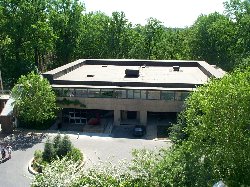 |
Lang Music Building | 1973 |
The Lang Music Building was the first building built by the College which
was dedicated entirely to the humanities - until that time, all the previous
academic buildings had been devoted to the study of the natural sciences.
Lang is home to the music department, the Underhill Music Library, and a concert
hall with a three-story window looking out on the Crum Woods. The Underhill
Music Library has more than 16,000 scores, books, and music periodicals, as
well as more than 16,000 sound recordings.
|
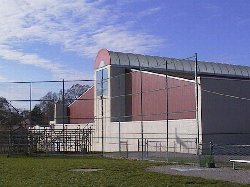 |
Tarble Pavilion | 1978 |
Tarble Pavilion is an expansion of the Lamb-Miller Field House. Along with
more storage space for the athletic teams, the Pavilion houses the College's
main basketball court and is used for physical education classes.
|
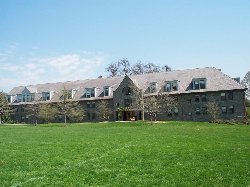 |
Mertz Hall | 1981 |
Mertz is the newest and fourth largest residence hall on campus, and also one
of the nicest and most popular. Most rooms in Mertz are of comparable size to
the larger rooms in other dorms, though probably none are bigger than the
largest rooms in Wharton. All rooms have carpeting, adequate natural (and
artificial) lighting, huge closets, and built-in wall thermometers. Almost
all rooms in Mertz are doubles and singles, though there are several two- and
three-room quads, as well. The dorm is divided into two halls on each of its
three floors; the corridors themselves are a nice compromise between the straight
line of Willets and the twisted labyrinth of Danawell. Like ML and Willets,
Mertz has a large common lounge on the first floor for dorm-wide gatherings.
Unfortunately, the lounges on the second and third floors are small considering
that they are shared by an entire floor, but the kitchens in the lounges are some
of the best on campus. Ground was broken for Harendes Hall on June 1, 1980. Apparently the administration originally made a mistake in who to credit for the money, as the building's name was soon changed to Mertz Hall. Mertz cost a total of $3 million to build and was dedicated on September 21, 1981. Population: 138 students
First-Year Students: 55
|
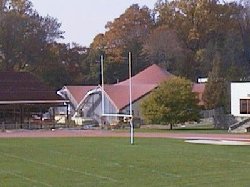 |
Ware Pool | 1981 |
In the mid-1960's, Swarthmore undertook a massive construction project that
included a new dorm, library, dining hall, and health center. As part of the
same construction project, the College also planned on building a pool at the
west end of the Field House, but abandoned the idea for more than a decade. On
October 18, 1980, the ground was broken for the new Ware Pool, even though the
College only had $500,000 of the $1.6 million that would be needed to complete
the building. Original proposals called for a large, shallow pool with a separate
diving well, but eventually the idea was consolidated into one Olympic-sized
pool. Half of Ware Pool's heating comes from solar energy, making it one of
the most environmentally-efficient buildings on campus. The pool is used by
the swim team, aquatics classes, and students and faculty of Swarthmore College.
|
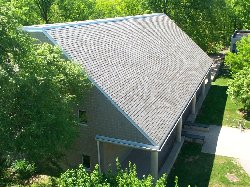 |
Cornell Science & Engineering Library | 1982 |
Cornell is home to books, periodicals, and other resources relating to the natural
sciences. Due to the wonderful layout of the library, Cornell is a common place
to find students of all disciplines studying. Large windows allow sunlight into
the entire building; indeed, the side of Cornell facing the Crum Woods is nothing
but a giant two-story window. The basement is one of the most popular study spots
on campus as it has large tables for groups to gather at, comfortable chairs for
individuals to relax in, and a spectacular view of the Crum. The second floor of
Cornell is quite possibly the quietest place at Swarthmore; talking is prohibited
on the entire floor, and dozens of study carols are available for individual use.
There are many public computers - mainly iMacs - spread throughout the building,
including one large lab on the second floor. In addition to numerous scientific
texts, a large repository of science fiction novels can be found on the second
floor of Cornell.
|
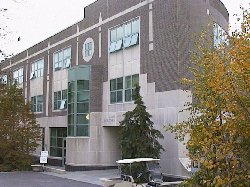 |
Lang Performing Arts Center | 1991 |
LPAC is the home of the theatre, dance, and music departments of Swarthmore
College. In addition to classrooms, there are several dance studios, an
art gallery, and a large stage for theater, dance, and drama productions. LPAC
also has a large movie theater which shows recent movie releases on Friday and
Saturday nights. LPAC and the Lang Music Building are connected on the second
floor by an outdoor walkway.
|
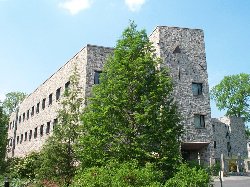 |
Kohlberg Hall | 1996 |
Kohlberg Hall is Swarthmore's newest and most modern building. In addition to
being the home of the departments of Economics, Modern Languages and Literatures,
and Sociology and Anthropology, Kohlberg houses the Credit Union, language lab,
faculty lounge, and a coffee bar. There are computer labs on the first and third
floors of the building, and classrooms of all sizes on all three floors. The
Kohlberg Coffee Bar has a wonderful view of both the grassy North Quad and the
Ruins Garden situated between it and Parrish, making it a favorite study spot and
hangout for students.
|
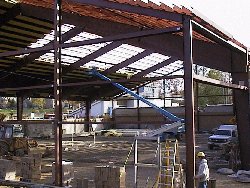 |
Mullan Tennis Center | 2000 |
The Mullan Tennis Center, located by the football field and Ware Pool, was completed
in the Spring of 2000. It houses three indoor tennis courts and a very large weight
room with modern equipment.
|
| Photo | Name | Estimated Date of Construction | Purpose |
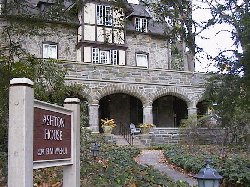 |
Ashton House | prior to 1963 |
Ashton House currently serves as the College guest house, though it
has been used as a dormitory in the past. It was acquired by Swarthmore
College in 1963, and was presumably a private residence before that. In
the late 70's, a group of students lived in Ashton as part of an ill-fated
Community Housing Project.4 More information on this can be
found on
Elizabeth Weber's Swarthmore history page.
|
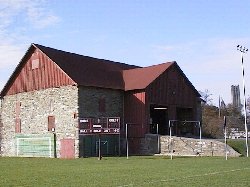 |
Barn | prior to 1864 |
The barn was one of the properties acquired by Swarthmore College when it
purchased land surrounding the college in 1878. As late as the 1940's, the barn
was home to horses and possibly other farm animals.2
Today, the barn is used for vehicle storage and maintenance.
|
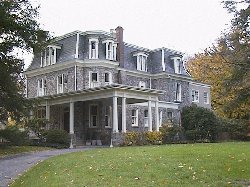 |
Courtney Smith House | prior to 1909 |
The Courtney Smith House is named in honor of Swarthmore's eighth president,
Courtney C. Smith, who died in office during the SASS crisis of 1969.2
(For more information, see
Elizabeth Weber's Swarthmore history page.) It was acquired by the College in
1909, though it may have been a private residence before that. The building serves as the
President's House, and is rumored to have a large swimming pool in the basement.
|
 |
Cratsley House | ???? |
The Cratsley House does not have a reason for existence, as far as can be
determined. It is located to the south of the campus, between the athletic
fields and Strath Haven Condominiums. The house is presumably named for
Edward K. Cratsley, a vice president of the College who took over as acting
president after Courtney Smith's death.2
|
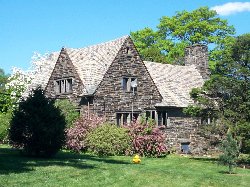 |
Delta Upsilon | ???? |
The Delta Upsilon fraternity lodge is home to one of Swarthmore's two surviving
fraternities, DU. Though not used for student housing, it is often used on the
weekends for all-campus parties.
|
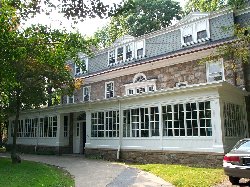 |
Mary Lyon Building 1 | prior to 1913 |
Mary Lyon 1, Wildcliff, was originally a private house that was purchased by the Mary Lyon
Schol when it opened in 1913. It was then converted into a dorm that also had classrooms.
After Swarthmore College bought the property, it converted ML 1 into faculty housing, which
it is still used for today. ML 1 is located on Harvard Ave. just south of ML 4. More on the history of the Mary Lyon buildings.
|
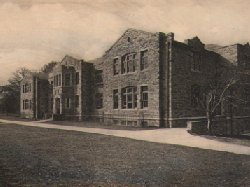 |
Mary Lyon Building 2 | 1921 |
Mary Lyon 2, Miller Crist, was originally built by the Mary Lyon School as the central
administrative building. It had a library, gym, auditorium, swimming pool, and classrooms.
Though it is unknown if it was ever used for student housing after Swarthmore acquired it,
the College once set up a full-scale model of a Dana room in February, 1966, and apparently
rented it out as housing for several years. Around 1980, Swarthmore converted ML2 into a
storage facility. In February, 1982, the Board of Managers gave the administration permission
to demolish Mary Lyon Buildings 2 and 3, but before they could demolish either, ML2 was
destroyed by arsonists on March 26, 1982. More on the history of the Mary Lyon buildings.
|
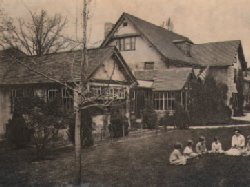 |
Mary Lyon Building 3 | prior to 1913 |
Mary Lyon 3, Seven Gables, was another private property bought by the Mary Lyon School
when it opened. It was used by the school as a dormitory, first for students in grades
1-8, then for junior college students after the elementary portion of the school closed.
Swarthmore used the building as faculty housing until it was converted to a men's dorm in
the 1960's. It was vacated before the 1981-82 school year in favor of the new Mertz, and
then was demolished shortly after the destruction of ML 2 in 1982. More on the history of the Mary Lyon buildings.
|
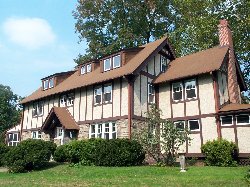 |
Mary Lyon Building 5 | prior to 1913 |
Mary Lyon 5, Hillcrest, was also a private house before the Mary Lyon school purchased
it. It contained mainly classrooms and seminar rooms, and was labeled the "French House"
on a map of the school. It presumably came under the control of the College when Swarthmore
bought the school's properties in 1946, though what purpose it has served since that date
is unknown. It still stands across the street from ML 4 on Strath Haven Ave.
More on the history of the Mary Lyon buildings.
|
 |
Mary Lyon Building 6 | ???? |
No information is known about ML6. More on the history of the Mary Lyon buildings.
|
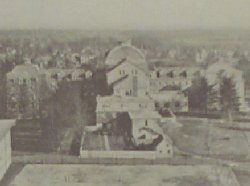 |
Parrish Annex | ???? |
Parrish Annex was a small building that was located just behind Parrish
on the site of the present-day Kohlberg Ruins Garden. It was demolished on
September 13, 1994 so that construction could begin on Kohlberg Hall. At
the time of its destruction, Parrish Annex housed the Personnel Office and
the Department of Modern Languages and Literatures.
|
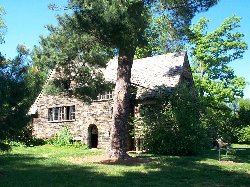 |
Phi Psi | ???? | Phi Psi's fraternity lodge is home to one of Swarthmore's two fraternities. |
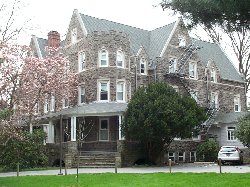 |
Pittenger Hall | between 1898-1901 |
Pittenger Hall, along with Palmer and Roberts, was originally one of three
buildings that formed the Swarthmore Preparatory School.1 Like
the other two PPR dorms, Pitt is an exceptionally quiet dorm with very little
hall life. The dorm does not actually have any sort of lounge space, so its
residents must travel through a covered passageway to Roberts to find a
lounge. Many of the first-year doubles are slightly smaller than the campus
norm, and all are dimly lit. However, the singles in Pittenger are of a
very respectable size and are quite popular with the upperclassmen. Due
to the lack of bathrooms in Pittenger, all bathrooms in the doom are co-ed.
Pittenger is located past the athletic fields at the edge of campus; it
is a five-minute walk to the main campus. Population: 50 students
First-Year Students: 18
|
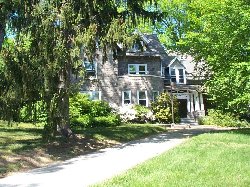 |
Robinson House | prior to 1900 |
Robinson House was being used as a student residence hall in 1970, when a
two-day student sit-in prompted the administration to convert it into
the Black Cultural Center.2 The BCC has a library, lounge,
kitchen, and several study rooms for students.1 It was
acquired by the college in 1955.
|
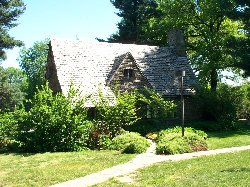 |
Sharples III | ???? |
Sharples III was originally the Phi Sigma Kappa fraternity house. After some period
of disuse following the disbanding of the fraternity, a student referendum taken in the
spring of 2000 decided that it would be converted to a student art gallery.
|
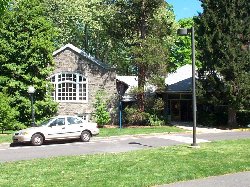 |
Whittier House | ???? |
Whittier House stands next to the Friends Meeting House on the North
Campus. No information is available on what Whittier is used for.
|
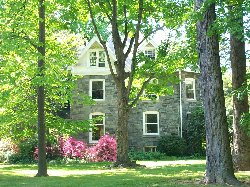 |
Woolman House | prior to 1926 |
Woolman House is Swarthmore's smallest dorm and the closest dorm located
off-campus. The college acquired it in 1926; prior to that it presumably existed
as a private residence. Until the 1999-2000 school year, the three-story building
housed only women; it was Swarthmore's last single-sex dorm. Most of the
doubles in the building are larger than the campus norm, and two of the
quads have private bathrooms. The isolation and relatively small size of
Woolman makes it perfect for a small group of friends to block together
for a year. Indeed, this was recognized as early as 1943, when the
College decided to make Woolman a "Language House" - the sixteen women
living there could only speak French while in their dorm. No first-year
students are assigned to Woolman. Population: 21 students
|
Sources:
1 - http://www.swarthmore.edu/
2 - Swarthmore College: An Informal History
3 - Alumni Bulletin
4 - Elizabeth Weber's Swarthmore History Articles
5 - The Swarthmorean
Dorm population statistics come from SCCS's
online telephone directory.
absolut swarthmore
last updated